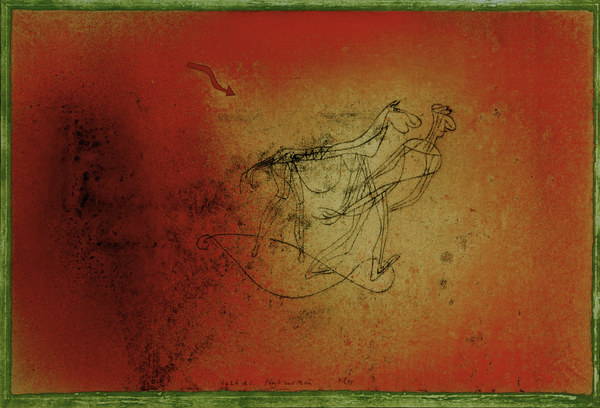A major exhibition of works by Paul Klee from the San Francisco Museum of Modern Art’s (SFMOMA) distinguished Djerassi collection—so named for its benefactor, Dr. Carl Djerassi, who first placed his Klee holdings on extended loan to the Museum in 1984, followed in 1988 by promised and full gifts of 85 works from the collection—was on view at the Museum from March 1 through June 8, 2003.
A Passion for Paul Klee: The Djerassi Collection at SFMOMA marked the first time Dr. Djerassi’s complete holdings, the largest collection of work by Klee in the western United States and considered among the finest in the world, were seen in their entirety. Featuring 140 works that range from Klee’s years as a high school student until his death in 1940, the exhibition revealed a comprehensive look at the 20th-century avant-garde master. The collection is primarily composed of works on paper and is almost evenly divided in number between Klee’s prints (both etchings and lithographs) and drawings and his watercolors. A Passion for Paul Klee was organized by Janet Bishop, curator of painting and sculpture; SFMOMA is the only venue.
“Dr. Djerassi’s very generous gifts and the extraordinary promise he made to SFMOMA of his entire Klee collection represent an invaluable public resource of rich and varied works by one of the most important artists of the 20th century,” said director Neal Benezra. “SFMOMA has benefited from Dr. Djerassi’s vision and support for nearly 20 years; we are honored to make his entire collection available to our audience for the first time.” Dr. Djerassi is a professor of organic chemistry at Stanford University whose accomplishments include the first synthesis of a steroid oral contraceptive—the birth control pill—for which he was awarded the National Medal of Science and elected into the National Inventors Hall of Fame. He is a published author of works of both fiction and nonfiction.
Paul Klee (1879–1940), born in Münchenbuchsee, just north of Bern, Switzerland’s capital, grew up in a musical family and was himself a violinist. Ultimately he opted to study art and in 1900 trained with neoclassicist Franz von Stuck at the Munich Academy, where he first met painter Vasily Kandinsky. As was standard academic practice, his training included anatomy lessons and life drawing from the nude; he later toured Italy for seven months, where he was exposed to early Christian and Byzantine art. In 1906 he married pianist Lili Stumpf and settled in Munich, then an important center for avant-garde art; their only child, Felix, was born there the following year. Klee’s friendship with Kandinsky prompted him to join Der Blaue Reiter (The Blue Rider), an expressionist group pivotal to the development of abstract art. Later, at the invitation of founder Walter Gropius, Klee taught at the esteemed Bauhaus from 1920–31; in 1931 he accepted a position at the Dusseldorf Academy, but was soon dismissed by the Nazis, who included 17 of his works in their infamous exhibition of “degenerate art,” Entartete Kunst, in 1937. After a move to Switzerland in 1933, Klee developed the crippling collagen disease, scleroderma, marked by a pathological thickening and hardening of the skin; he died from its complications in 1940.
As seen in the exhibition A Passion for Paul Klee: The Djerassi Collection at SFMOMA, Klee worked in such a wide variety of styles that he defies simple categorization. The works on view demonstrate the breadth of his output, from portraits to abstractions, from landscapes to figurative works. Beginning with his classically based etchings of 1903–5, continuing through his impressionistic, expressionist and cubist endeavors in the first decades of the century and followed by his alternately highly structured and free-flowing works of later years, Klee’s oeuvre, in its own way, parallels the broad developments in 20th-century European art. The earliest work in the collection, Untitled, 1895, is an intimate pen-and-ink landscape on gold-edged paper. Other early works include etchings from his Inventions series, collectively known as Opus I, that reveal both his assimilation and rejection of his academic art training, rendered in what he termed his “sour” style: the works provide a biting commentary on contemporary existence.
A trip to Tunisia in 1914 inspired Klee to use color and marked the beginning of his fully mature style; the watercolor

Fata Morgana zur Zee (Fata Morgana on the Sea), 1918,
is composed of translucent areas of pink, violet and sea green, outlined in thin black ink.
Initiale (Initial), 1917, rendered in delicate pastel shades of blue, green, orange and violet, features a prominent letter “I,” recalling a medieval illuminated manuscript. (Revealing his satisfaction with the work, Klee himself inscribed it with the letter “S Kl,” denoting Sonderklasse, or “special class.”)
The hand-colored lithograph

Ein Genius serviert ein kleines Frühstück, Engel bringt das Gewünschte (A Spirit Serves a Small Breakfast, Angel Brings the Desired), 1920,
is based on a pen-and-ink drawing of the same name from 1915, but with the addition of a pale pink wash over the central portion as well as a deeply pigmented frame and symbol of a heart.
Selections from Klee’s work between 1921–31, known as the “Bauhaus Years,” included

Die Heilige vom innern Licht (The Saint of Inner Light), 1921; color lithograph;

Die erhabene Seite (The Sublime Aspect), 1923;

Pferd und Mann (Horse and Man), 1925;

and Heldenmutter (Hero Mother), 1927.
These works incorporate many of the constructivist tendencies and principles taught at the Bauhaus along with Klee’s personal intuition and poetic lyricism, creating fantastical works that stretch the limits of the imagination.
Selections from the 1930s emphasized Klee’s appreciation for the abstract form as a vehicle for creative expression. The latest work in the exhibition, an untitled composition dating from 1940, featured a landscape fashioned from rows of vividly colored rectangles on one side and an abstracted, wide-eyed angel on the other.